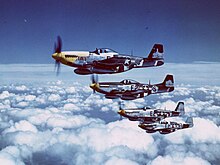
Back مقاتلة مواكبة Arabic Caça d'escorta Catalan Doprovodný stíhač Czech Caza de escolta Spanish جنگنده اسکورت Persian Saattohävittäjä Finnish Chasseur d'escorte French Caccia di scorta Italian Eskortinis naikintuvas Lithuanian Spremljevalni lovec Slovenian

The escort fighter was a concept for a fighter aircraft designed to escort bombers to and from their targets. An escort fighter needed range long enough to reach the target, loiter over it for the duration of the raid to defend the bombers, and return.
A number of twin-engined heavy fighters with high fuel capacity were designed for escort duties prior to the outbreak of World War II. Such heavy fighters largely failed in their intended escort role during the war, as they were commonly outmaneuvered by more agile single-engined fighters. As the war progressed, longer-range fighter designs and the use of drop tanks allowed single-engined fighters to perform escort duties. In the post-war era the introduction of jet engines and their inherent short range made escort fighters very difficult to build. The related concept of a penetration fighter emerged briefly in the 1950s and again in the 1960s, but did not result in any production aircraft. Parasite fighters—small aircraft designed to be carried by a specialized bomber—were seen as a possible solution to the limited ranges of most traditional escort fighters. First experimented with in WWI, the U.S.-designed XF-85 Goblin would emerge as the last dedicated parasite fighter design and was abandoned in 1949 due to technical issues as well as the advent of practical aerial refueling.
The escort role has been diminished as modern air combat doctrine places a heavy emphasis on the idea of air superiority, and its importance in the ability of an air force to carry out effective operations. Air superiority is defined as a situation in which an air force dominates an airspace to such a degree as to be able to carry out any operations with no interference from enemy air combatants. Fighting an opponent with air superiority in a given battlespace is much harder, as any offensive or defensive tactics are likely to be overwhelmed.[1]
- ^ Lt. Col. Stoll, Hans G. "Luftwaffe Doctrine and Air Superiority throughout WWII: The Luftwaffe Experience." United States Air War College, 1994. p. 1.